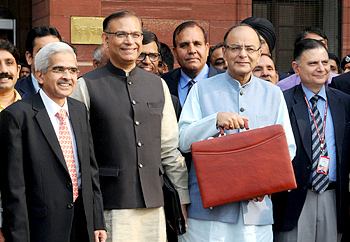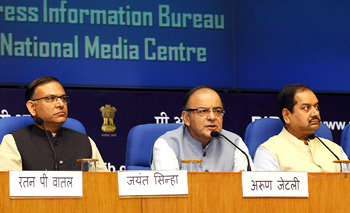INDIAN ARMED FORCES CHIEFS ON OUR RELENTLESS AND FOCUSED PUBLISHING EFFORTS

SP Guide Publications puts forth a well compiled articulation of issues, pursuits and accomplishments of the Indian Army, over the years

"Over the past 60 years, the growth of SP Guide Publications has mirrored the rising stature of Indian Navy. Its well-researched and informative magazines on Defence and Aerospace sector have served to shape an educated opinion of our military personnel, policy makers and the public alike. I wish SP's Publication team continued success, fair winds and following seas in all future endeavour!"

Since, its inception in 1964, SP Guide Publications has consistently demonstrated commitment to high-quality journalism in the aerospace and defence sectors, earning a well-deserved reputation as Asia's largest media house in this domain. I wish SP Guide Publications continued success in its pursuit of excellence.
Defence Budget 2016-2017
 |
By Lt. General P.C. Katoch Former Director General of Information Systems, Indian Army |


Defence Minister Mohan Parrikar chaired a Defence Acquisition Council (DAC) meeting on February 22, holding that arms acquisition proposals worth 1.5 lakh crore were cleared by the NDA government since it assumed office in May 2014, of which 81 schemes have fully matured and another 66 schemes worth around 2 lakh crore have been accorded AoN (acceptance of necessity or preliminary approvals) over the last two years. But Parrikar took note that 314 cases had not fructified, of which 86 schemes worth 1.5 lakh crore were close to the final stages of approval. Although he directed these be cleared in next 4-5 months but the financial year (FY) closes on March 31 and going by the pace of procurements, even projects given accorded AON will make little progress by then. In January 2016, MoD was struggling to exhaust its modernisation funds with almost 40% of its capital budget unspent; as much as 37,355 crore of the capital modernisation budget of 93,675 crore. Non-finalization of procurement of Rafale and BAEs M777 howitzers contributed towards this but these are recurring narratives every year. The Parliament’s Standing Committee on Defence had noted in April 2015 that “such under-spending leads to a situation where the preparation of Defence Forces are nowhere near the target”. The Committee called for a “non-lapsable and roll-on allocation” fund for 5-10 years for defence equipment. Such a non-lapsable fund, administered by experts with strict controls on timelines, would reduce bureaucratic hurdles and be more attuned to practical realities. Even during UPA I, Jaswant Singh as Defence Minister had recommended that the unspent funds of defence budget must be allowed go into the next financial year. Significantly, 6000 crore (official figure) had been surrendered on 31 March 2015.
As for Defence Budget 2016-2017, the 47 page pdf of the Finance Minister’s speech in Parliament for Union Budget 2016-2017 on February 29 placed on the net by a media house, contains less than 12 lines on defence that read, “Defence of every square inch of our mother land comes before anything else. So far, we have been over dependent on imports, with its attendant unwelcome spin-offs. Our Government has already permitted FDI in defence so that the Indian-controlled entities also become manufacturers of defence equipments, not only for us, but for export. We are thus pursuing the Make in India policy to achieve greater self-sufficiency in the area of defence equipment, including aircraft. Members of this august House would have noted that we have been both transparent and quick in making defence equipment related purchase decisions, thus keeping our defence forces ready for any eventuality. This year too, I have provided adequately for the needs of the armed forces. As against likely expenditure of this year of 2,22,370 crore the budget allocation for 2015-16 is 2,46,727 crore.” On face value, it indicates that the inter-dependence between security (read defence) and economy-cum-development continues to be ignored. Little wonder then that when talking of challenges ahead, the Finance Minister made no mention of mounting threats to national security. But there is much more that appears to have been broad-brushed. Some issues that need to be examined are:
- This is perhaps the first time that defence budget allocation in two successive FY have been exactly the same both in FY 2015-2016 and 2016-2017 the allocation stands at 2,46,727 crore.
- Def Budget 2015-2016 allocation of 2,46,727 crore amounted to about US$ 40 billion but the same allotment in current FY is in the backdrop of the Rupee having depreciated plenty over the past year. This plus taking into account the yearly inflation rates in defence procurement, defence allocation for FY 2016-2017 is far less despite efforts to portray more than adequate by saying that “against likely expenditure of this year of 2,22,370 crore the budget allocation for 2015-16 is 2,46,727 crore”; implying that 24,357 crores is the extra cushion which it is not because of reasons mentioned.
- The figure of 2,22,370 as likely expenditure too needs to be taken with a pinch of salt. Since October 2015, the military has been negotiating with the defence and finance ministries to finalize financial allocations for the coming financial year, 2016-17, projecting figures taking into account the inflation but as reported the Finance Ministry has cut down these requests.
- There has been talk in recent past of added expenditure on account OROP and 7th Pay Commission, even though full OROP is yet to be sanctioned (read letter from Rajeev Chandershekhar, MP Rajya Sabha to the Defence Minister dated February 23 regarding ‘Anomalies in One Rank One Pension Scheme’ available on the net) and 7th CPC having largely missed out the military. But considering that as much as 37,355 crore of the capital modernization budget of 93,675 crore of FY 2015-2016 remained unspent in January 2016, 66 schemes worth around 2 lakh crore have only been accorded preliminary approval over the last two years, of which that 314 cases had not fructified, what will be the status on 31 March 2016 and how much unspent funds will actually be surrendered by MoD, no matter official figures.
In terms of capital budget, equipment worth 1,81,450 crore ($26.9 billion) is already sanctioned for the Army. Even if the payment for these contracts are theoretically in 10 installments (number of installments agreed may even be less) FY 2016-2017 requires 18,145 crore over and above 21,574 crore committed previous year totaling to capital allocation required to the tune of 39,713 crore ($5.9 billion). Naval procurements include submarines, stealth frigates, logistic support vessels, anti-submarine and counter-mine vessels and, ship-borne helicopters, adding up to 2,96,800 crore. Again, one of the 10 installments implies 29,680 crores, and catering for committed liabilities this would total up to 53,591 crore. The IAF is looking to conclude contracts for the Rafale, extending service life of Jaguars and and a range of helicopters. Contracts worth 1,72,600 crore require urgent conclusion, with 17,260 crore payable in FY 2016-2017. That takes the IAF capital allocation to 48,741 crore. If the Military’s demands were to be met, the capital allocation required itself would be 1,63,561 crore, somewhat less than the revenue allocation; some 2.25% of the GDP.
There is no doubt that the government needs to boost expenditure in fields like education, food, agriculture, healthcare, creation of jobs etc. At the same time can we ignore: increasing China-Pakistan threat; foreign aided ‘third front’ within our borders in addition to other insurgencies; poor equipping of our military over past decade with 50% equipment obsolete and 30% provisioned indigenously sub-standard; enormous rise in Chinese defence expenditure; defence assistance to Pakistan by the US and China; and, conflict having enlarged to the cyberspace, space and electromagnetic domains. Defence analysts and scholars in the past have been recommending defence allocation of 2.5% of the GDP.
Sure the government must boost expenditure in fields like education, food, agriculture, healthcare, creation of jobs etc. At the same time can we ignore: increasing China-Pakistan threat; foreign aided ‘third front’ within our borders in addition to other running insurgencies; poor equipping of our military over past decade with 50% equipment obsolete and 30% provisioned indigenously sub-standard; enormous rise in Chinese defence expenditure and combat capability rise of PLA; defence assistance to Pakistan by the US and China; and, conflict having enlarged to the cyberspace, space and electromagnetic domains. At one time, France too was a developing country like India but then President Charles de Gaulle took a conscious decision in consistently boosting the defence budget for almost a decade, making France a powerful nation that no enemy dare attack. Last year, President Hollande announced that France would increase its defence budget by close to Euros four billion over four years to cope with rising terrorist threat. India faces a terrorist threat far greater than France.
Development being the right flavor, defence allocation of 2.5% or even 2.25% of the GDP would appear unrealistic but what is significant to note is that while the defence allocation in FY 2015-2016 stood at only 1.7% of GDP, the FY 2016-2017 allocation has gone below even that, not having taken into account the inflation while talking of looking up economy and better GDP. To this end, Defence Budget 2016-2017 amounts to a negative budget over the previous year, which would make our adversaries mighty happy. Merely cut-pasting the previous year’s allocation was hardly expected. Hollow announcements by successive governments like “as much funds needed by military will be made available” may happen even now but mean little. Additionally, the Parliament’s Standing Committee on Defence recommendation for a “non-lapsable and roll-on allocation” fund for 5-10 years for defence equipment must be followed through by the government. Besides as mentioned many times in these columns, Make in India is not the be all and end all of defence. It is about time the government restructures the higher defence organization including inducting military professionals in the MoD and appointing a CDS to synergize the military, instead of a puppet permanent Chairman of COSC with no operational powers.
Photo Credit: PIB





